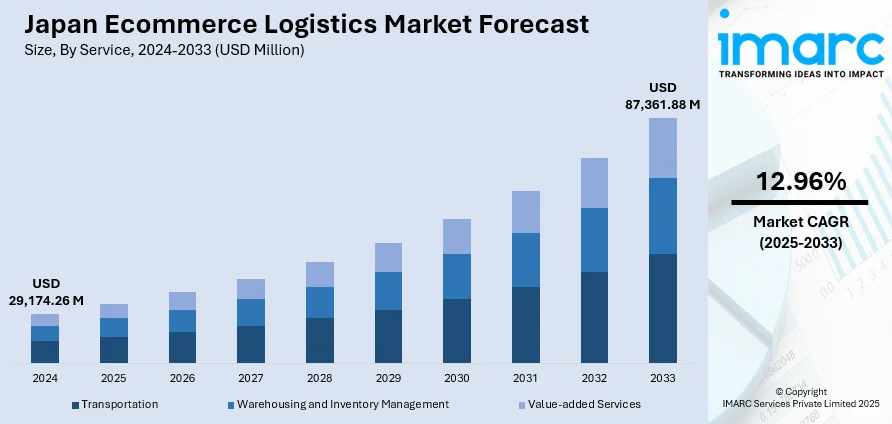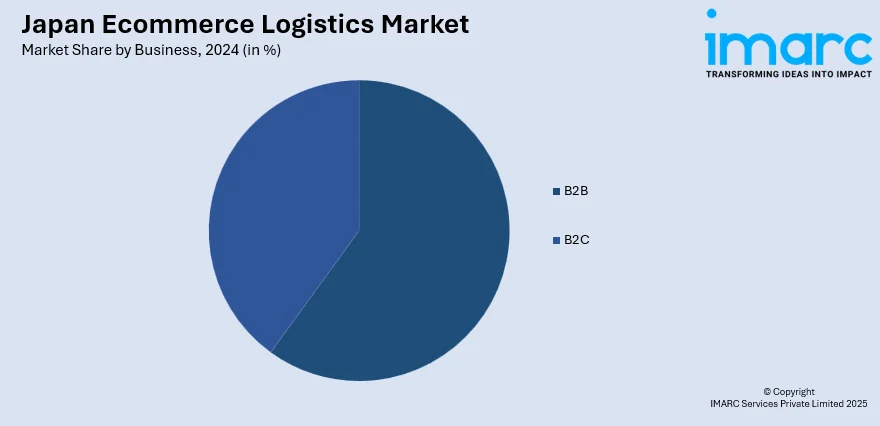
Japan Ecommerce Logistics Market Size, Share, Trends and Forecast by Service, Business, Destination, Product, and Region, 2025-2033
Japan Ecommerce Logistics Market Overview:
The Japan ecommerce logistics market size reached USD 29,174.26 Million in 2024. Looking forward, IMARC Group expects the market to reach USD 87,361.88 Million by 2033, exhibiting a growth rate (CAGR) of 12.96% during 2025-2033. The rapid growth of online shopping, rising consumer expectations for fast and reliable delivery, and the need to address labor shortages. Technological advancements such as automation, artificial intelligence (AI), and robotics are enhancing operational efficiency. Government support for digital transformation and infrastructure upgrades further accelerates innovation. Additionally, cross-border e-commerce is expanding, pushing logistics providers to improve international shipping capabilities. These factors collectively fuel the Japan ecommerce logistics market share for smarter, faster, and more scalable logistics solutions in Japan.
|
Report Attribute
|
Key Statistics
|
|---|---|
|
Base Year
|
2024 |
|
Forecast Years
|
2025-2033
|
|
Historical Years
|
2019-2024
|
| Market Size in 2024 | USD 29,174.26 Million |
| Market Forecast in 2033 | USD 87,361.88 Million |
| Market Growth Rate 2025-2033 | 12.96% |
Japan Ecommerce Logistics Market Trends:
Expansion of Micro-Fulfillment Centers
To remain competitive with the increasing demand for fast deliveries, Japanese logistics companies are creating micro-fulfillment centers in key cities. These small, technologically advanced warehouses enable firms to stock high-demand items nearer to urban consumers, shortening delivery times significantly. They are especially useful in completing last-mile deliveries more effectively, enabling firms to respond quickly to customer orders. Micro-fulfillment centers also minimize dependence on large, remote distribution centers, which tend to have trouble meeting stringent delivery windows. This strategy enhances flexibility in managing inventory and enables businesses to scale up operations more nimbly. Retailers are employing these centers for services such as next-day or same-day delivery. In a customer convenience-driven market, these conveniently placed centers are emerging as a central element of logistics planning and service differentiation.

Automation and AI Revolutionizing Logistics
Japan's logistics sector for e-commerce is also transforming on a massive scale, driven by automation and artificial intelligence (AI). Robotics is being adopted by logistics firms to sort, pack, and transport goods with minimal human intervention, while AI is used to plan delivery routes and inventory management for increased speed and accuracy. The drivers are ubiquitous labor shortages and increasing demand for speedy, safe deliveries. Autonomous delivery trucks and intelligent logistics platforms are in the test phase for mass application. Facilitating this change, the Japanese government has committed more than ¥10 trillion (approximately $65 billion) to increase AI and semiconductor research. The strategic investment is meant to fortify infrastructure and speed up AI use across industries, including logistics. Not only do these innovations lower business expenses, but they also make logistics companies competitive in a growing more demanding e-commerce environment.
Surge in Cross-Border E-Commerce Logistics
Increased global online shopping has compelled Japanese logistics companies to improve their cross-border delivery services. Consumers are purchasing products from foreign brands, which are driving logistics companies to upgrade their capacities in international shipping. This includes making customs processes better, making returns easier, and tracking international orders better. Logistics companies are also making alliances with foreign e-commerce websites to make cross-border transactions seamless. There is an increased focus on developing smooth shopping and delivery processes for customers buying from overseas. These initiatives are streamlining the access to a broader range of products for Japanese consumers, as well as benefiting overseas sellers who want to make inroads into the Japanese market. With heightened competition and expectations, being able to operate cross-border logistics economically becomes a powerful advantage for logistics firms in Japan.
Japan Ecommerce Logistics Market Segmentation:
IMARC Group provides an analysis of the key trends in each segment of the market, along with forecasts at the country and regional levels for 2025-2033. Our report has categorized the market based on service, business, destination, and product.
Service Insights:
- Transportation
- Warehousing and Inventory Management
- Value-added Services
- Labeling
- Packaging
The report has provided a detailed breakup and analysis of the market based on the service. This includes transportation, warehousing and inventory management, and value-added services (labeling and packaging).
Business Insights:

- B2B
- B2C
A detailed breakup and analysis of the market based on the business have also been provided in the report. This includes B2B and B2C.
Destination Insights:
- Domestic
- International/Cross Border
The report has provided a detailed breakup and analysis of the market based on the destination. This includes domestic and international/cross border.
Product Insights:
- Fashion and Apparel
- Consumer Electronics
- Home Appliances
- Furniture
- Beauty and Personal Care Products
- Others
A detailed breakup and analysis of the market based on the product have also been provided in the report. This includes fashion and apparel, consumer electronics, home appliances, furniture, beauty and personal care products, and others.
Regional Insights:
- Kanto Region
- Kansai/Kinki Region
- Central/ Chubu Region
- Kyushu-Okinawa Region
- Tohoku Region
- Chugoku Region
- Hokkaido Region
- Shikoku Region
The report has also provided a comprehensive analysis of all the major regional markets, which include Kanto, Kansai/Kinki, Central/ Chubu, Kyushu-Okinawa, Tohoku, Chugoku, Hokkaido, and Shikoku Region.
Competitive Landscape:
The market research report has also provided a comprehensive analysis of the competitive landscape. Competitive analysis such as market structure, key player positioning, top winning strategies, competitive dashboard, and company evaluation quadrant has been covered in the report. Also, detailed profiles of all major companies have been provided.
Japan Ecommerce Logistics Market News:
- In April 2025, AnyMind Group partnered with Shopify to launch the "Commerce DX Project" in Japan, aiming to unify D2C, cross-border e-commerce, and physical retail. The collaboration offers businesses an end-to-end e-commerce solution, from website creation to logistics and marketing. It enhances customer insights through integrated data and supports global expansion with multi-language, multi-currency capabilities. This initiative empowers brands to streamline operations and scale efficiently in Japan and beyond.
- In December 2024, Alibaba launched "Tao," a cross-border e-commerce platform in Japan, offering around 3 million products with localized services, including Japanese-language support and diverse payment options. To boost customer trust, it provides a 40-day free return policy and partners with Yamato and Sagawa for logistics. Tao aims to capture Japan’s evolving e-commerce market by blending international product access with domestic convenience and efficient delivery.
- In March 2024, Mitsui & Co. and Shopify Japan launched “Plus Shipping,” a digital delivery service supporting e-commerce merchants in Japan. Integrating with Japan Post, Sagawa, and Yamato, it streamlines delivery orders and payments without separate contracts. The service simplifies logistics, reduces shipment tasks by up to 93%, and offers flexible transport options. It addresses Japan’s delivery challenges by enhancing efficiency and offering special rates through a unified, one-stop solution.
Japan Ecommerce Logistics Market Report Coverage:
| Report Features | Details |
|---|---|
| Base Year of the Analysis | 2024 |
| Historical Period | 2019-2024 |
| Forecast Period | 2025-2033 |
| Units | Million USD |
| Scope of the Report | Exploration of Historical Trends and Market Outlook, Industry Catalysts and Challenges, Segment-Wise Historical and Future Market Assessment:
|
|
Services Covered |
|
| Businesses Covered | B2B, B2C |
| Destinations Covered | Domestic, International/Cross Border |
| Products Covered | Fashion and Apparel, Consumer Electronics, Home Appliances, Furniture, Beauty and Personal Care Products, Others |
| Regions Covered | Kanto Region, Kansai/Kinki Region, Central/ Chubu Region, Kyushu-Okinawa Region, Tohoku Region, Chugoku Region, Hokkaido Region, Shikoku Region |
| Customization Scope | 10% Free Customization |
| Post-Sale Analyst Support | 10-12 Weeks |
| Delivery Format | PDF and Excel through Email (We can also provide the editable version of the report in PPT/Word format on special request) |
Key Questions Answered in This Report:
- How has the Japan ecommerce logistics market performed so far and how will it perform in the coming years?
- What is the breakup of the Japan ecommerce logistics market on the basis of service?
- What is the breakup of the Japan ecommerce logistics market on the basis of business?
- What is the breakup of the Japan ecommerce logistics market on the basis of destination?
- What is the breakup of the Japan ecommerce logistics market on the basis of product?
- What is the breakup of the Japan ecommerce logistics market on the basis of region?
- What are the various stages in the value chain of the Japan ecommerce logistics market?
- What are the key driving factors and challenges in the Japan ecommerce logistics market?
- What is the structure of the Japan ecommerce logistics market and who are the key players?
- What is the degree of competition in the Japan ecommerce logistics market?
Key Benefits for Stakeholders:
- IMARC’s industry report offers a comprehensive quantitative analysis of various market segments, historical and current market trends, market forecasts, and dynamics of the Japan ecommerce logistics market from 2019-2033.
- The research report provides the latest information on the market drivers, challenges, and opportunities in the Japan ecommerce logistics market.
- Porter's five forces analysis assist stakeholders in assessing the impact of new entrants, competitive rivalry, supplier power, buyer power, and the threat of substitution. It helps stakeholders to analyze the level of competition within the Japan ecommerce logistics industry and its attractiveness.
- Competitive landscape allows stakeholders to understand their competitive environment and provides an insight into the current positions of key players in the market.
Need more help?
- Speak to our experienced analysts for insights on the current market scenarios.
- Include additional segments and countries to customize the report as per your requirement.
- Gain an unparalleled competitive advantage in your domain by understanding how to utilize the report and positively impacting your operations and revenue.
- For further assistance, please connect with our analysts.
 Request Customization
Request Customization
 Speak to an Analyst
Speak to an Analyst
 Request Brochure
Request Brochure
 Inquire Before Buying
Inquire Before Buying




.webp)




.webp)












